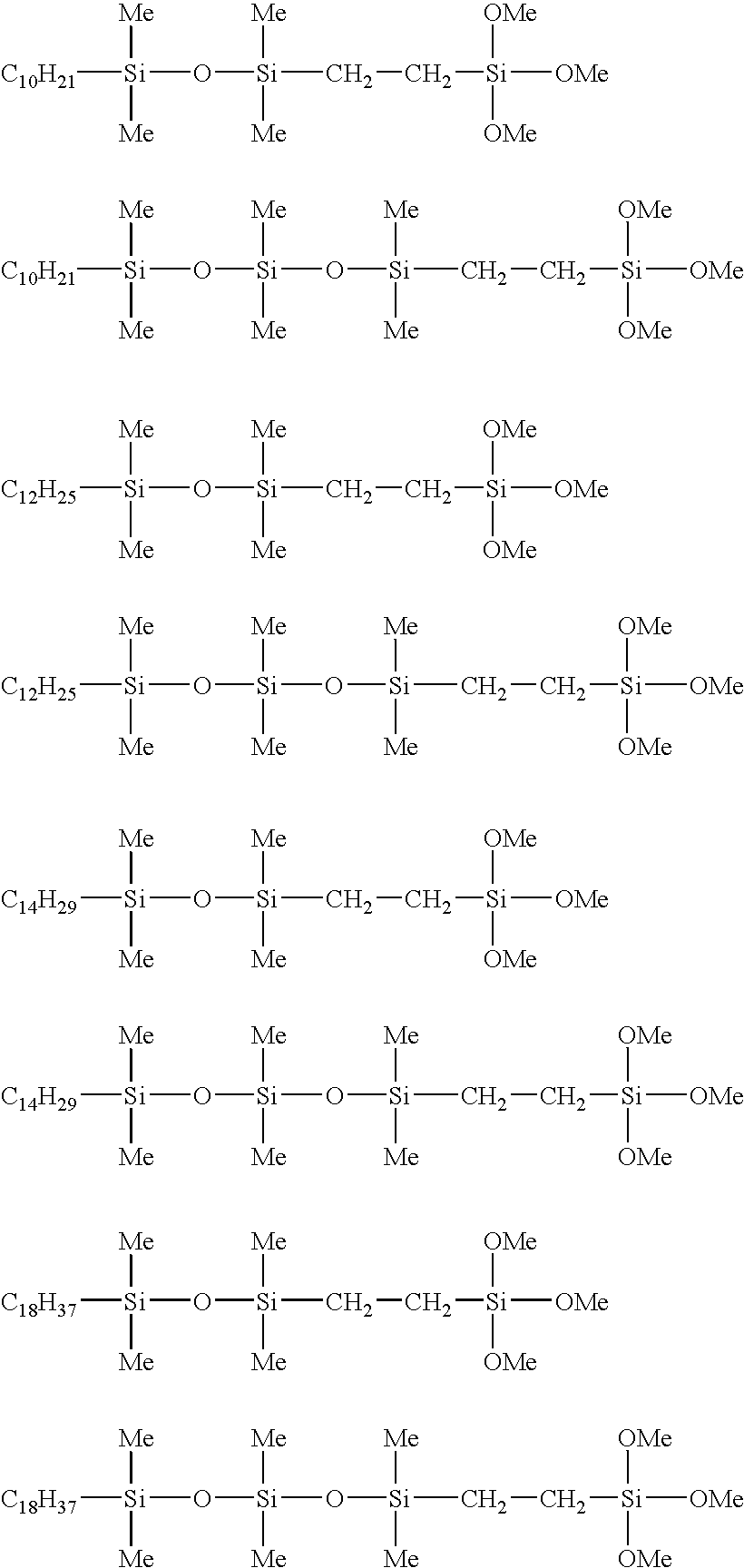Heat-conductive silicone composition and cured product thereof
a silicone composition and heat-conductive technology, applied in the direction of adhesives, layered products, transportation and packaging, etc., can solve the problems of dramatic deterioration in the handling properties and moldability of the composition, increased heat generation, and significant problem of dealing with heat, so as to reduce the amount of heat that is absorbed into the heat-radiating component, reduce the effect of heat generation
- Summary
- Abstract
- Description
- Claims
- Application Information
AI Technical Summary
Benefits of technology
Problems solved by technology
Method used
Image
Examples
synthesis example 1
[0118]A 1 liter round-bottom separable flask with a 4-necked separable cover was fitted with a stirrer, a thermometer, a Graham condenser and a dropping funnel. The separable flask was then charged with 250.0 g (1.2 mols) of 1,1,3,3,5,5-hexamethyltrisiloxane, and the temperature was raised to 70° C. Once this temperature had been reached, 0.6 g of a 2% by mass 2-ethylhexanol solution of chloroplatinic acid was added, and the resulting mixture was stirred at 70° C. for 30 minutes. Subsequently, 88.9 g (0.6 mols) of trimethoxyvinylsilane was added dropwise over a one hour period with the temperature held at 70 to 80° C., thereby initiating a reaction. Following completion of this dropwise addition, the reaction was continued with the temperature held at 70 to 80° C. During the reaction, the unreacted trimethoxyvinylsilane was refluxed. The progress of the reaction was tracked by gas chromatography, and the point where the chromatographic peak for trimethoxyvinylsilane disappeared was ...
synthesis example 2
[0123]A 1 liter round-bottom separable flask with a 4-necked separable cover was fitted with a stirrer, a thermometer, a Graham condenser and a dropping funnel. The separable flask was then charged with 235.6 g (1.2 mols) of 1-tetradecene, and the temperature was raised to 70° C. Once this temperature had been reached, 0.6 g of a 2% by mass 2-ethylhexanol solution of chloroplatinic acid was added, and the resulting mixture was stirred at 70° C. for 30 minutes. Subsequently, 356.71 g (1.0 mols) of the 1-trimethoxysilylethyl-1,1,3,3,5,5-hexamethyltrisiloxane obtained in the synthesis example 1 was added dropwise over a two hour period, thereby initiating a reaction. Following completion of this dropwise addition, the reaction was continued with the temperature held at 70 to 80° C. During the reaction, the unreacted 1-trimethoxysilylethyl-1,1,3,3,5,5-hexamethyltrisiloxane was refluxed. The progress of the reaction was tracked by gas chromatography, and the point where the chromatograph...
synthesis example 3
[0128]A 1 liter round-bottom separable flask with a 4-necked separable cover was fitted with a stirrer, a thermometer, a Graham condenser and a dropping funnel. The separable flask was then charged with 537.3 g (4.0 mols) of 1,1,3,3-tetramethyldisiloxane, and the temperature was raised to 70° C. Once this temperature had been reached, 1.0 g of a 2% by mass 2-ethylhexanol solution of chloroplatinic acid was added, and the resulting mixture was stirred at 70° C. for 30 minutes. Subsequently, 296.5 g (2.0 mols) of trimethoxyvinylsilane was added dropwise over a two hour period with the temperature held at 70 to 80° C., thereby initiating a reaction. Following completion of this dropwise addition, the reaction was continued with the temperature held at 70 to 80° C. During the reaction, the unreacted trimethoxyvinylsilane was refluxed. The progress of the reaction was tracked by gas chromatography, and the point where the chromatographic peak for trimethoxyvinylsilane disappeared was dee...
PUM
| Property | Measurement | Unit |
|---|---|---|
| particle size | aaaaa | aaaaa |
| particle size | aaaaa | aaaaa |
| particle size | aaaaa | aaaaa |
Abstract
Description
Claims
Application Information
 Login to View More
Login to View More - R&D
- Intellectual Property
- Life Sciences
- Materials
- Tech Scout
- Unparalleled Data Quality
- Higher Quality Content
- 60% Fewer Hallucinations
Browse by: Latest US Patents, China's latest patents, Technical Efficacy Thesaurus, Application Domain, Technology Topic, Popular Technical Reports.
© 2025 PatSnap. All rights reserved.Legal|Privacy policy|Modern Slavery Act Transparency Statement|Sitemap|About US| Contact US: help@patsnap.com



